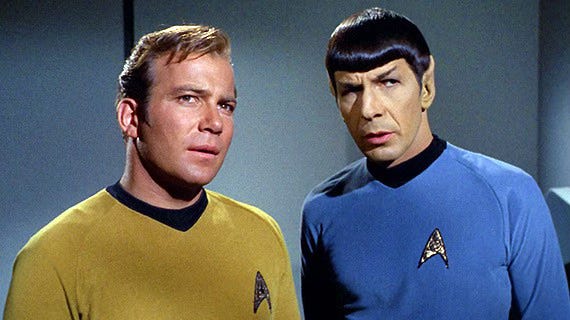This week’s rebroadcast highlights a post from 2011 on the original pitch documents for Star Trek. While some of the links in the original post have gone dead, we present new sources here so the information can live long and prosper.

Several blogs have recently linked to this 1964 pitch document1 by Gene Roddenberry laying out his initial vision for Star Trek. It’s great reading for anyone interested in the Star Trek universe or TV writing in general.
Documents like this are still common in television. I’ve heard them called different things: formats, treatments, show outlines, write-ups, pitch documents.
Whatever you call them, they generally cover a few topics:
What the show is (logline, genre, themes, similarities to existing shows)
What happens in typical episodes
The main characters
The primary locations/sets
Special opportunities and challenges
Future episode ideas
In the Library, you can see similar write-ups for D.C., Alaska and Ops.
In the case of Star Trek, it’s not clear at what point in the process this document was written. Generally, pitching a show is something you do in person, with writer(s) meeting with executives. If the pitch goes well, you might leave a document like this behind — in which case it’s called, quite unimaginatively, a leave-behind.
2024 Update from John:
Wait! What about no writing left behind?
For years, the WGA and I have warned about the issues surrounding written material left behind after a pitch. From the writer’s perspective, it can amount to free work. You’re undercutting yourself and your fellow writers by giving a potential employer material they should be paying for. From the studio’s perspective, it’s a potential lawsuit over copyright infringement if they produce something similar to what’s on the paper.
These issues mostly come up when you’re pitching on material the studio owns, like a book or a movie franchise. It’s generally more of a concern in features, where they might be meeting with six screenwriters about a project. If you’re pitching something that’s wholly yours like a TV series — or if you’re already being paid by the company as part of an overall deal — there’s much less cause for concern.
Now back to 2011.
Executives like leave-behinds because it gives them something they can use to pitch the show to their bosses. Agents and seasoned writers caution against them, because it gives executives specifics with which to find fault.
So instead of a leave-behind, you might send something like this over a few days later, writing up the pitch so everyone agrees what kind of show was discussed in the room, including issues that came up. Ideally, you would want your deal closed before emailing this over, but everything in television happens with a sense of rushed deadlines, so that’s hardly a given.
Looking through Roddenberry’s Star Trek write-up, it’s tempting to focus on all the things that changed. The Enterprise is the Yorktown. The captain is neither Pike or Kirk, but Robert M. April. Spock has red skin. Bones is Bones, but his real name is Phillip Boyce.
But it’s more helpful to marvel on how much of the vision and philosophy for Star Trek shows up in this early incarnation:
The “Parallel Worlds” concept is the key to the STAR TREK format.
It means simply that our stories deal with plant and animal life, plus people, quite similar to that on Earth. Social evolution will also have interesting points of similarity to ours. There will be differences, of course, ranging from the subtle to the boldly dramatic, out of which comes much of our color and excitement. (And, of course, none of this prevents an occasional “far our” tale thrown in for surprise and change of pace.)
A quick read through the proposed storylines gives a very strong sense of what the show would become. Some of these ideas became episodes; most didn’t. But they all feel like they could be part of the show.
You can read the whole thing here.
Are you enjoying this newsletter?
📧 Forward it to a friend and suggest they check it out.
🔗 Share a link to this post on social media.
🗣 Have ideas for future topics (or just want to say hello)? Reach out to Chris via email at inneresting@johnaugust.com, Mastodon @ccsont@mastodon.art, or Threads @ccsont@threads.net
FYI: Links directly to a PDF file.



